This CE Center article is no longer eligible for receiving credits.
Designers are no strangers to education and certifications. Years of school followed by continuing education requirements and a number of available specialties and designations offer never-ending opportunities for architects to further educate themselves on design trends, technology, best practices, and more. Today, the benefit of professional and specialized training is available to many in the design and construction industry, including the contractors and construction professionals tasked with the installation of these advanced systems and new materials.
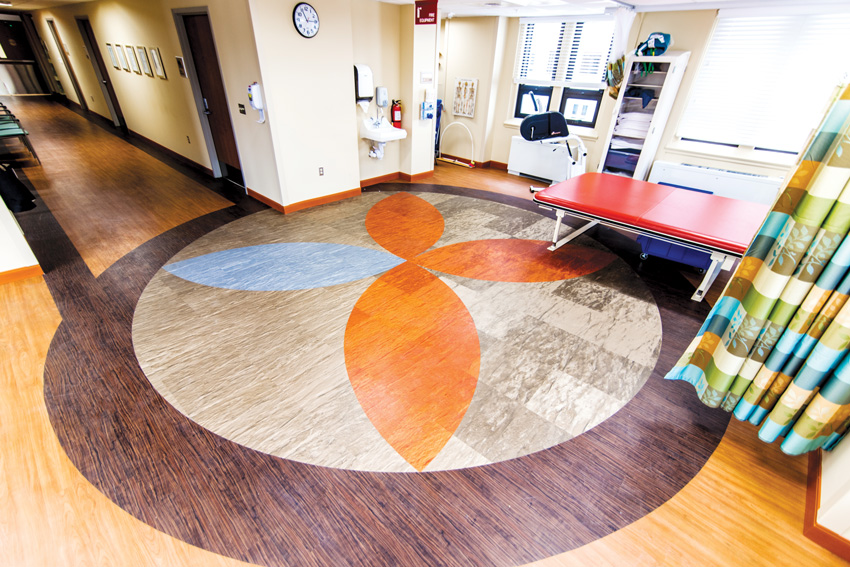
All photos courtesy of INSTALL
New training programs are available to help installers, contractors, and construction-related personnel complete projects correctly while protecting patients and creating safe and sterile health-care interiors.
There is no other place where extra training may be more important than projects in health-care facilities. Improper product installation can create hiding places for germs and bacteria, breeding grounds for mold and mildew, and, ultimately, compromise the safety and sterility of the health-care space. Beyond the potential hazards presented by poor or improper installations, fixing them costs time and money, often a significant amount.
This course will explore two new certifications designed to create health-care facilities that will protect patients by providing the sterile and safe environments they need both before and during the occupation of the facilities. First, it will take a closer look at the way in which the United States Department of Veterans Affairs (VA) altered its specification and alleviated its flooring installation headaches by partnering with the International Standards and Training Alliance (INSTALL), the construction industry-endorsed floorcovering installation and certification program, to ensure that qualified flooring professionals were tasked with installing the carpet, athletic carpet, and resilient flooring throughout VA facilities. Then a special new training designed to teach contractors and construction teams as well as hospital staff and designers the infection-control risk assessment (ICRA) protocols and procedures will be reviewed.
The VA’S Flooring Issues
As of September 2014, the VA reported that it owned 6,081 buildings covering more than 151.5 million square feet, and it had a flooring-related problem that could potentially affect every square foot. “Like any other entity that owns and operates many institutional buildings, we have had a long history of flooring failure,” says Orest Burdiak, principal interior designer at the VA.
While faulty products caused some of the issues, improper or substandard installation was the key reason for the vast majority of the flooring failures that occurred. “From poor floor prep to improper testing for moisture to inadequate moisture mitigation, we have experienced a laundry list of installation-related flooring issues across hundreds of projects,” Burdiak explains. These flawed flooring installations cost the VA considerable time and money, delaying project completions and, in many instances, requiring that flooring be completely or partially replaced in order to make the interior a suitable health-care environment.
“At the end of the day, as a government entity, we owe it to the taxpayers to approach construction projects in a way that delivers quality facilities in a cost-effective manner,” Burdiak says. “While the VA is a nonproprietary organization that doesn’t endorse specific products or manufacturers, we realized the significant costs we kept incurring for subpar flooring installations and decided to require that installers working on VA projects have a certain level of training as a way to reduce the amount we spent fixing mistakes.”
There are many issues that can and have arisen during a flooring installation at a VA facility. Some of the most common and, in some cases, most detrimental, include poor flooring preparation, improper flash coving, sloppy seaming, and pattern-matching mistakes. These flawed installation techniques can cause the flooring to fail prematurely, buckling, lifting, bubbling, blistering, or breaking, and create a situation where the flooring becomes a breeding ground for mold and mildew. All of these problems can pose significant health and safety risks, especially in health-care environments.
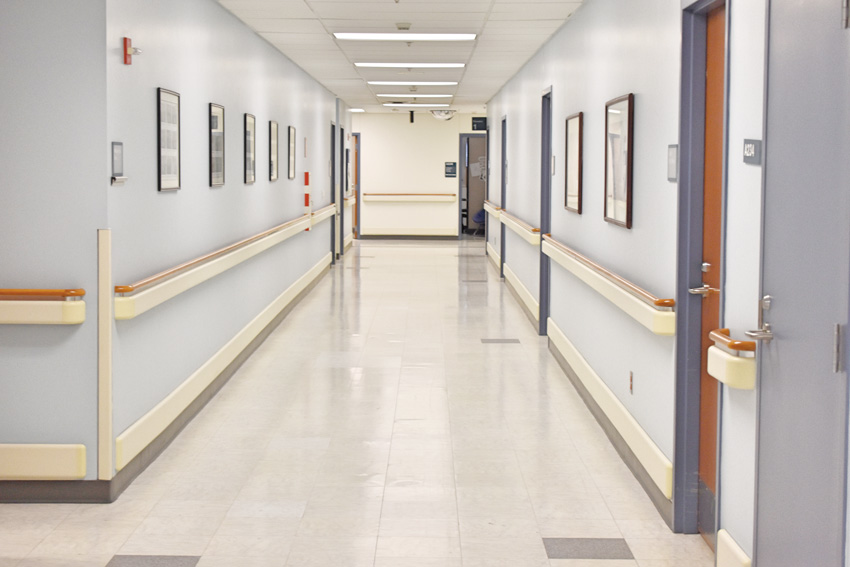
Improper flooring installation has caused floorcoverings to bubble and fail prematurely in numerous VA projects.
Poor Flooring Preparation
Flooring preparation refers to the preparation of the substrate, the material upon which the flooring will be installed. While there are many aspects of the substrate that must be evaluated, the amount of moisture in the concrete is one of the most critical because the substrate must be dry enough to properly install flooring upon it. Applying a floorcovering when the substrate is too wet can result in flooring failure, alkalinity issues, and rampant mold and mildew growth.
Although concrete substrates are commonly found on commercial projects, the amount of drying time necessary before the flooring can be installed must be determined on a project-by-project basis because drying times for concrete slabs vary based on concrete mix, slab thickness, and weather conditions.
The specific flooring selected for a project must also be considered. Different types of flooring respond to and manage moisture differently. For example, the structures of some types of floorcovering provide escape routes where moisture from the concrete can evaporate. Other floorcoverings are impermeable so moisture collects between the floorcovering and the substrate, where it can dissolve the adhesive holding the floor in place or host mold.
In order to determine that the concrete substrate is dry enough for a successful floorcovering installation, the level of moisture in the concrete must be measured and, if necessary, steps to mitigate the potential issues caused by the moisture present should be taken. A common moisture-mitigation technique is to put down an impermeable barrier between the substrate and the floorcovering so the moisture won’t affect the adhesive. Selecting a different adhesive or type of floorcovering better suited to withstand the existing moisture levels is also a possible mitigation solution.
Accurate moisture testing and adequate moisture mitigation are vitally important to the success of the floorcovering installation. Unfortunately, moisture tests are often taken improperly or not taken at all, and moisture mitigation efforts can be lackluster or ineffective. When flooring is installed upon a surface that is not properly prepared, the only way to fix it is to rip out the floorcovering, ensure the substrate is correctly prepped, and reinstall, which can be extremely costly.
Improper Flash Coving
Flash coving is a technique that is commonly used in health-care environments to make the floors easier to clean by eliminating corners and tight edges that can collect germs and bacteria. With flash coving, instead of installing the flooring to the edge of the wall and then installing a separate wall base, which creates different edges and surfaces where germs and dirt can hide, the floor sheet is extended up the wall to form a wall base that is contiguous with the floorcovering. These integral coves are easily wiped or swept clean.
Unfortunately, flash coving is a significantly more advanced type of flooring installation. Flash coving can fail for several reasons, such as a missing cove stick, which is a unique type of support used to install the floorcovering up the wall. Without the necessary support, the cove can split and require a full replacement of the flooring.
Sloppy Seaming
Joining multiple sheets of flooring together in a way that makes the entire floorcovering one beautiful, sterile, and seamless flooring surface is the goal of a flooring installation, especially in a health-care setting. Heat welding is the process commonly used to join sheets of resilient flooring material together. However, poor hot or cold welding technique or inexperienced installers’ work often result in less-than-perfect and problematic seams that are unable to hold the flooring materials in place as needed.
Bad seams in resilient flooring can feature gaps or lips, both tripping hazards and dirt traps. Failed heat weld seams will physically split, creating openings in the flooring surface that compromise sterility and cleanliness by allowing bacteria and dirt to hide in the cracks and providing any mold and mildew that may exist under the floor access to the interior space.
Unfortunately, heat welding is a very nuanced technique, and it is easy for things to go awry. Problems can arise if the seams are trimmed and grooved too quickly, if the installer moves too fast, if the welding gun is not at the correct temperature, if the wrong welding rod is used, or if adhesive makes its way into the seam—and these are just a few of the potential issues.
Some manufacturers of rubber flooring stipulate a process called cold welding, or chemical welding. As the name implies, chemical welding uses a chemical solvent to fuse the two sheets together. While cold welding does not require the specialty tools used in the heat-welding process, it does require knowledgeable and experienced installers to avoid common pitfalls that ultimately compromise the appearance and performance of the flooring.
If sloppy seaming practices have resulted in gapping, lipped, or split floor seams, the problem is more than unsightly. These imperfections in the flooring surface compromise the sterility and safety of the health-care space and will be continually aggravated with every cart or shoe that shuffles over it. If the problem is noticed immediately, there may be an opportunity to correct a bad seam, but once the flooring surface is damaged, it must be replaced.
Pattern-Matching Mistakes
In the health-care space, many designers use flooring as an aesthetic element and select surfaces that feature ornate patterns or use flooring to support wayfinding for patients, visitors, and staff. Whether aesthetic or informative, getting the pattern installed correctly is important to realizing the design intent of the space.
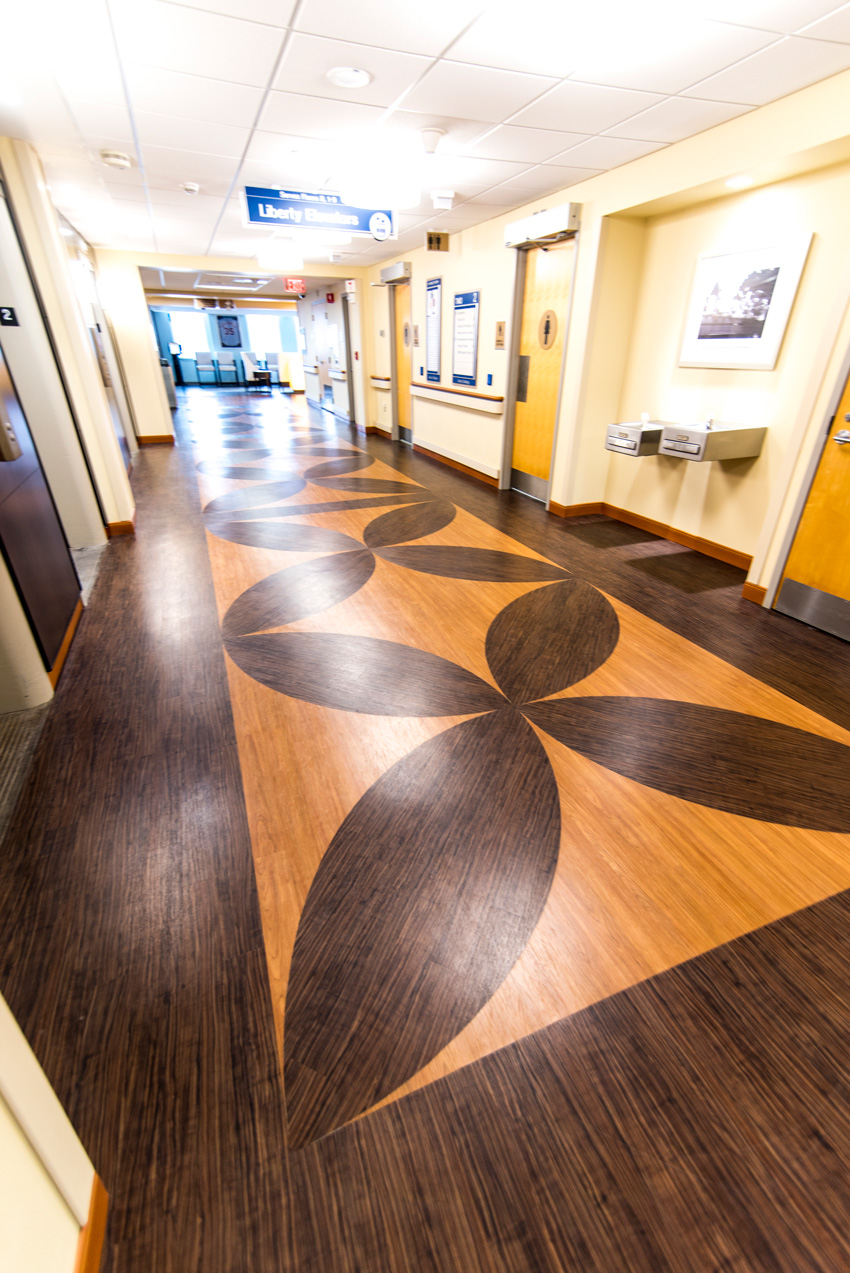
The INSTALL training program helps installers avoid the many common problems that can occur when installing a patterned floorcovering.
There are several problems that often occur when an inexperienced contractor attempts to install a patterned flooring surface. The floorcovering can be cut and fit improperly, compromising the appearance of the pattern. It can also be difficult to maintain the pattern in areas that have strange dimensions. Patterns can be accidentally elongated or shrunk depending upon the space, and poor or novice planning may quickly result in patterns that are not centered or that simply seem to run out of an area or collide with a wall.
Designers are no strangers to education and certifications. Years of school followed by continuing education requirements and a number of available specialties and designations offer never-ending opportunities for architects to further educate themselves on design trends, technology, best practices, and more. Today, the benefit of professional and specialized training is available to many in the design and construction industry, including the contractors and construction professionals tasked with the installation of these advanced systems and new materials.

All photos courtesy of INSTALL
New training programs are available to help installers, contractors, and construction-related personnel complete projects correctly while protecting patients and creating safe and sterile health-care interiors.
There is no other place where extra training may be more important than projects in health-care facilities. Improper product installation can create hiding places for germs and bacteria, breeding grounds for mold and mildew, and, ultimately, compromise the safety and sterility of the health-care space. Beyond the potential hazards presented by poor or improper installations, fixing them costs time and money, often a significant amount.
This course will explore two new certifications designed to create health-care facilities that will protect patients by providing the sterile and safe environments they need both before and during the occupation of the facilities. First, it will take a closer look at the way in which the United States Department of Veterans Affairs (VA) altered its specification and alleviated its flooring installation headaches by partnering with the International Standards and Training Alliance (INSTALL), the construction industry-endorsed floorcovering installation and certification program, to ensure that qualified flooring professionals were tasked with installing the carpet, athletic carpet, and resilient flooring throughout VA facilities. Then a special new training designed to teach contractors and construction teams as well as hospital staff and designers the infection-control risk assessment (ICRA) protocols and procedures will be reviewed.
The VA’S Flooring Issues
As of September 2014, the VA reported that it owned 6,081 buildings covering more than 151.5 million square feet, and it had a flooring-related problem that could potentially affect every square foot. “Like any other entity that owns and operates many institutional buildings, we have had a long history of flooring failure,” says Orest Burdiak, principal interior designer at the VA.
While faulty products caused some of the issues, improper or substandard installation was the key reason for the vast majority of the flooring failures that occurred. “From poor floor prep to improper testing for moisture to inadequate moisture mitigation, we have experienced a laundry list of installation-related flooring issues across hundreds of projects,” Burdiak explains. These flawed flooring installations cost the VA considerable time and money, delaying project completions and, in many instances, requiring that flooring be completely or partially replaced in order to make the interior a suitable health-care environment.
“At the end of the day, as a government entity, we owe it to the taxpayers to approach construction projects in a way that delivers quality facilities in a cost-effective manner,” Burdiak says. “While the VA is a nonproprietary organization that doesn’t endorse specific products or manufacturers, we realized the significant costs we kept incurring for subpar flooring installations and decided to require that installers working on VA projects have a certain level of training as a way to reduce the amount we spent fixing mistakes.”
There are many issues that can and have arisen during a flooring installation at a VA facility. Some of the most common and, in some cases, most detrimental, include poor flooring preparation, improper flash coving, sloppy seaming, and pattern-matching mistakes. These flawed installation techniques can cause the flooring to fail prematurely, buckling, lifting, bubbling, blistering, or breaking, and create a situation where the flooring becomes a breeding ground for mold and mildew. All of these problems can pose significant health and safety risks, especially in health-care environments.

Improper flooring installation has caused floorcoverings to bubble and fail prematurely in numerous VA projects.
Poor Flooring Preparation
Flooring preparation refers to the preparation of the substrate, the material upon which the flooring will be installed. While there are many aspects of the substrate that must be evaluated, the amount of moisture in the concrete is one of the most critical because the substrate must be dry enough to properly install flooring upon it. Applying a floorcovering when the substrate is too wet can result in flooring failure, alkalinity issues, and rampant mold and mildew growth.
Although concrete substrates are commonly found on commercial projects, the amount of drying time necessary before the flooring can be installed must be determined on a project-by-project basis because drying times for concrete slabs vary based on concrete mix, slab thickness, and weather conditions.
The specific flooring selected for a project must also be considered. Different types of flooring respond to and manage moisture differently. For example, the structures of some types of floorcovering provide escape routes where moisture from the concrete can evaporate. Other floorcoverings are impermeable so moisture collects between the floorcovering and the substrate, where it can dissolve the adhesive holding the floor in place or host mold.
In order to determine that the concrete substrate is dry enough for a successful floorcovering installation, the level of moisture in the concrete must be measured and, if necessary, steps to mitigate the potential issues caused by the moisture present should be taken. A common moisture-mitigation technique is to put down an impermeable barrier between the substrate and the floorcovering so the moisture won’t affect the adhesive. Selecting a different adhesive or type of floorcovering better suited to withstand the existing moisture levels is also a possible mitigation solution.
Accurate moisture testing and adequate moisture mitigation are vitally important to the success of the floorcovering installation. Unfortunately, moisture tests are often taken improperly or not taken at all, and moisture mitigation efforts can be lackluster or ineffective. When flooring is installed upon a surface that is not properly prepared, the only way to fix it is to rip out the floorcovering, ensure the substrate is correctly prepped, and reinstall, which can be extremely costly.
Improper Flash Coving
Flash coving is a technique that is commonly used in health-care environments to make the floors easier to clean by eliminating corners and tight edges that can collect germs and bacteria. With flash coving, instead of installing the flooring to the edge of the wall and then installing a separate wall base, which creates different edges and surfaces where germs and dirt can hide, the floor sheet is extended up the wall to form a wall base that is contiguous with the floorcovering. These integral coves are easily wiped or swept clean.
Unfortunately, flash coving is a significantly more advanced type of flooring installation. Flash coving can fail for several reasons, such as a missing cove stick, which is a unique type of support used to install the floorcovering up the wall. Without the necessary support, the cove can split and require a full replacement of the flooring.
Sloppy Seaming
Joining multiple sheets of flooring together in a way that makes the entire floorcovering one beautiful, sterile, and seamless flooring surface is the goal of a flooring installation, especially in a health-care setting. Heat welding is the process commonly used to join sheets of resilient flooring material together. However, poor hot or cold welding technique or inexperienced installers’ work often result in less-than-perfect and problematic seams that are unable to hold the flooring materials in place as needed.
Bad seams in resilient flooring can feature gaps or lips, both tripping hazards and dirt traps. Failed heat weld seams will physically split, creating openings in the flooring surface that compromise sterility and cleanliness by allowing bacteria and dirt to hide in the cracks and providing any mold and mildew that may exist under the floor access to the interior space.
Unfortunately, heat welding is a very nuanced technique, and it is easy for things to go awry. Problems can arise if the seams are trimmed and grooved too quickly, if the installer moves too fast, if the welding gun is not at the correct temperature, if the wrong welding rod is used, or if adhesive makes its way into the seam—and these are just a few of the potential issues.
Some manufacturers of rubber flooring stipulate a process called cold welding, or chemical welding. As the name implies, chemical welding uses a chemical solvent to fuse the two sheets together. While cold welding does not require the specialty tools used in the heat-welding process, it does require knowledgeable and experienced installers to avoid common pitfalls that ultimately compromise the appearance and performance of the flooring.
If sloppy seaming practices have resulted in gapping, lipped, or split floor seams, the problem is more than unsightly. These imperfections in the flooring surface compromise the sterility and safety of the health-care space and will be continually aggravated with every cart or shoe that shuffles over it. If the problem is noticed immediately, there may be an opportunity to correct a bad seam, but once the flooring surface is damaged, it must be replaced.
Pattern-Matching Mistakes
In the health-care space, many designers use flooring as an aesthetic element and select surfaces that feature ornate patterns or use flooring to support wayfinding for patients, visitors, and staff. Whether aesthetic or informative, getting the pattern installed correctly is important to realizing the design intent of the space.

The INSTALL training program helps installers avoid the many common problems that can occur when installing a patterned floorcovering.
There are several problems that often occur when an inexperienced contractor attempts to install a patterned flooring surface. The floorcovering can be cut and fit improperly, compromising the appearance of the pattern. It can also be difficult to maintain the pattern in areas that have strange dimensions. Patterns can be accidentally elongated or shrunk depending upon the space, and poor or novice planning may quickly result in patterns that are not centered or that simply seem to run out of an area or collide with a wall.
The VA’S Solution: Specify Installation Training
The VA was well aware of the problems that could occur when unqualified contractors installed floorcoverings. To reduce the amount of time and money spent fixing floorcovering installation mistakes, the decision was made to add an item to three sections of the VA’s Master Specification. Now contractors installing carpet, athletic carpet, or resilient tile flooring in VA buildings must have attained certain certifications in flooring installation.
VA Master Spec Language
The VA Master Specification is a comprehensive set of more than 372 qualitative requirements that guide the selection of products, materials, and workmanship for VA construction projects. Architects, engineers, and construction professionals employed on VA projects are tasked with the responsibility of satisfying the tenets of the Master Specification. Changes were made to three sections of the Master Specification to require that flooring installers attain a specific type or level of installation training. The sections that now include these installation quality-assurance criteria are: Section 09 65 19: Resilient Tile Flooring, Section 09 68 00: Carpeting, and Section 09 68 21: Athletic Carpeting.
VA Floorcovering Installer Qualifications
The new language stipulates the qualifications for professionals installing resilient tile flooring, carpeting, and athletic carpeting in the following way.
Installer qualifications: A company specializing in installation with minimum three years’ experience and employing experienced flooring installers who have retained and currently hold an INSTALL Certification or a certification from a comparable certification program.
Installers to be certified by INSTALL or a comparable certification program with the following minimum criteria:
- U.S. Department of Labor approved four-year apprenticeship program, 160 hours a year
- Career-long training
- Manufacturer-endorsed training
- Fundamental journeyman skills certification
In short, according to the VA’s Master Specification, flooring installers selected to work on VA projects (installing either carpet, athletic carpet, or resilient flooring) must have attained, and currently hold, an INSTALL certification or a certification from a comparable certification program.
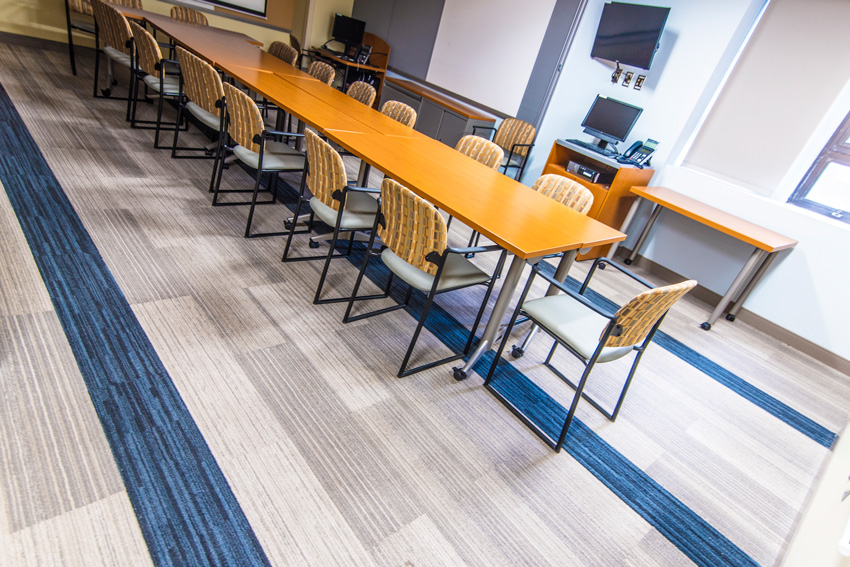
The VA modified its Master Specification to require floorcovering installers working on carpet, athletic carpet, or resilient flooring projects to have attained and currently hold an INSTALL certification.
Introducing Install and The Install Training Program
INSTALL is an association of flooring professionals that includes major flooring manufacturers, contractors, and installers across the United States and Canada. The comprehensive INSTALL training and certification program was designed to instill the knowledge of floorcovering best practices, offer extensive hands-on training opportunities, and keep participants current on the various emerging trends, technologies, and materials of the flooring industry as they change over the course of a career.
Four-Year Apprenticeship Program
The four-year apprenticeship program consists of classroom training, practical training, and on-the-job training. The training curriculum provides core skills for proper floor preparation, installation, and finishing procedures for carpet, resilient flooring, resinous flooring, hardwood flooring, substrate prep, concrete polishing, artificial turf, and more. Apprentices will also learn important safety skills, tips, and procedures to improve productivity on the jobsite, and gain green building awareness and a foundational knowledge of how to work in accordance with green building standards.
One important feature of the INSTALL training program is the inclusion of the flooring manufacturers. INSTALL believes that manufacturers have the best information and insight about their own products, and the INSTALL team works tirelessly to ensure that the manufacturer-approved information is incorporated into the training program and updated regularly to capture the latest in technique and technology. This dedication to conveying manufacturer-supplied quality and current content has helped the INSTALL training program become the most endorsed and recommended training program in the industry.
INSTALL also develops standards for determining fundamental installer skills, skill competence, theoretical knowledge, and hands-on skill testing. These INSTALL standards are reviewed regularly by the U.S. Department of Labor and by the labor departments of Canadian provincial governments, ensuring the apprenticeship program remains approved by the Department of Labor.
Fundamental Journeyman Skills Certification
Upon the successful completion of the apprenticeship program, the flooring installer, now considered a journeyman, has the opportunity to earn various floorcovering certifications from INSTALL and become INSTALL certified. There are six different certifications available: carpet, resilient, substrate preparation, master resilient certification, wood floor installation, and wood floor sanding and finishing. Each floorcovering certification must be individually earned by demonstrating a mastery of specific skill sets. Each certification lasts four years.
Ongoing, Career-Long Training
INSTALL training doesn’t end with the one-time award of a certificate. INSTALL-certified installers must complete an additional eight hours of INSTALL training every four years to maintain each certification.
INSTALL Contractors
INSTALL Contractors are companies that have hired employee installers that have been INSTALL trained, tested, and certified. This unique INSTALL-equipped structure enables INSTALL-certified installation teams to be more engaged throughout the project, which offers the installers access to better information and enables them to more actively identify and communicate potential issues and resolve them before they compromise the success of the installation.
INSTALL Warranty Contractors
There is an elite group of INSTALL Contractors that are backed by an industry-exclusive, free, third-party installation warranty. Referred to as INSTALL Warranty Contractors, these companies exclusively employ INSTALL-certified flooring installers as well as satisfy a variety of other criteria related to financial solvency, experience, and demonstrated success.
The INSTALL Warranty on Labor is a free, extended, third-party warranty on installation that is beyond the manufacturer’s warranty. “Since beginning the INSTALL Warranty, we have underwritten more than $400 million worth of work and have never had to pay a single claim,” explains John McGrath, executive director of INSTALL.
There are currently 11,000 INSTALL-trained installers in the United States and Canada. There are also 400 INSTALL Contractors employing INSTALL-certified installers and 45 INSTALL Warranty Contractors available to complete work backed by the INSTALL Warranty.
How INSTALL-Certified Teams Avoid Common Installation Issues
As previously described, there are a number of common mistakes that can be made during a floorcovering installation. INSTALL-certified professionals have received the necessary training and know-how to avoid the typical pitfalls that can plague a floor prep, compromise a flash cove, weaken a seam, or destroy a pattern.
Here is an example of how using an INSTALL contractor on a job enables the floorcovering installers to modify the usual process and provide successful outcomes, even when subpar conditions exist. During a project, installation of the floorcoverings is often scheduled to be one of the last major tasks that must be completed with installers typically scheduled to show up the day the installation is to begin. As such, installers can often find themselves with scant information on the conditions of the substrate before they arrive and without the wiggle room in the timeline to mitigate a moisture concern in the substrate.
When working with an INSTALL contractor, there is more of a relationship between the flooring installers and the broader construction team, enabling the flooring professionals to gain access to the substrate earlier in the process to take multiple moisture and alkalinity measurements. This information gives installers a better idea of the status of the substrate as the installation deadline nears and enables them to communicate potential issues and proactively find solutions. Also, the contractor has better visibility around when the substrate will be ready and can delay scheduling the flooring professionals until conditions are optimal for installation.
The VA's Results After Specifying Install Training
Since modifying the Master Specification in 2015 to require INSTALL-certified professionals be selected to install carpet, athletic carpet, and resilient flooring in VA facilities, the results have been positive. “I haven’t heard of any flooring failures on large projects since our relationship started, and while its tough to oversee and monitor small projects across hundreds of facilities, the benefit to our employees, patients, and bottom line has been immediate and profound,” Burdiak says.
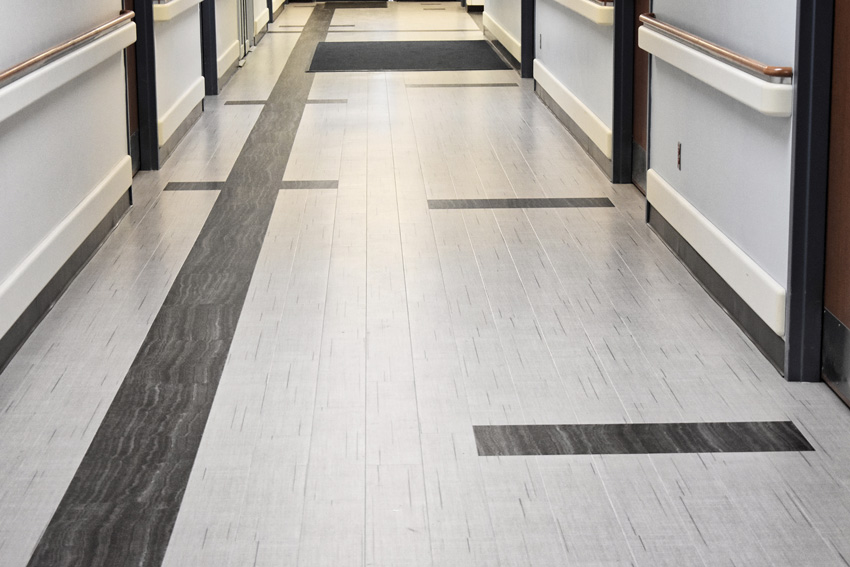
Since modifying the Master Specification in 2015, the VA has seen an immediate and significant improvement in the quality of its floorcovering installations, and the impact to the employees, patients, and bottom line has been profound.
While the INSTALL training is required for any professional installing carpet, athletic carpet, or resilient flooring in a VA facility, the knowledge and training of INSTALL-certified floorcovering installers offers an incredible benefit to any health-care project. Avoid headaches, delays, and the costs to fix installation mistakes by incorporating training or quality assurance language into the flooring section of the project specification requiring that only appropriately trained professionals be hired to install the flooring.
Looking beyond the nuanced world of flooring installation in health care and the impact that trained professionals can have creating safe and sterile environments, there have been recent developments in the training available to the broader health-care design and construction team. An important new program has been created to help designers, general contractors, interior systems carpenters, other building trades, and hospital staff address the very unique needs and dangers that construction work can pose in an occupied health-care environment.
Potential Dangers of Construction In Occupied Health-Care Facilities
When an occupied health-care facility begins an upgrade, expansion, or renovation project, construction activities can introduce dirt, debris, and contaminants such as mold, asbestos, lead, and bacteria into an environment where immune-compromised people come to heal. Exposure to these elements can put patients at risk for acquiring other diseases and infections that could cause greater harm and further jeopardize their recovery and well-being. Containment of these potentially infectious and harmful agents is a critical aspect of keeping patients, staff, and the construction team safe and healthy during construction in the occupied health-care space.
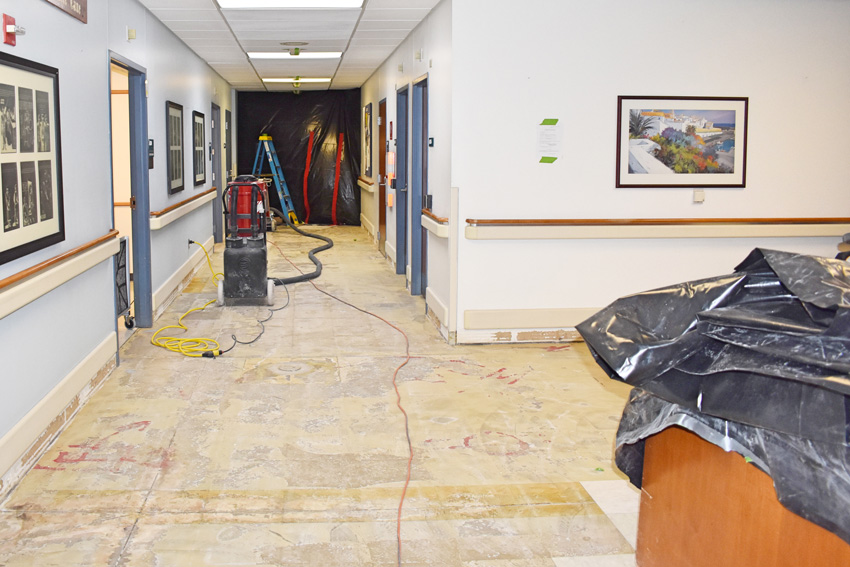
Construction activities can introduce dirt, debris, and contaminants into the health-care environment that could be dangerous for immune-compromised patients trying to recover.
While many large urban hospitals and health-care systems have experienced infection-control departments and detailed infection-control plans, successful infection control relies on the construction team’s ability to properly implement and execute the plan. Smaller or more rural health-care facilities may not have the same infection-control resources and depend more on the experience and know-how of the construction team working on the project.
New Training: Infection-Control Risk Assessment (ICRA) Best Practices
Luckily, a special training has been developed to teach contractors and construction teams as well as hospital staff and designers the infection-control risk assessment (ICRA) protocols and procedures designed to protect the health and safety of everyone involved during construction in an occupied health-care facility. This ICRA training program covers best practices for contaminant control, mold remediation, air quality maintenance, communication, and documentation, as well as addresses worker responsibilities, consequences, and recommended work practices. Training participants gain the knowledge and tools necessary to prevent these potentially deadly pathogens from escaping the construction area and hurting someone. The key is control.
Controlling the Movement of Pathogens
Contaminants unearthed during the construction process can infiltrate patient and staff environments through the HVAC system or be carried through the facility on the bottom of shoes, clothing, carts, or any other number of potential conduits that exist. With proper ICRA training, the construction team can effectively contain the construction area by constructing containment barriers, carefully controlling the potentially contaminated airflow, and using safeguards and equipment to prevent the transmission of harmful agents on shoes, clothing, and other objects that may enter and leave the construction site.
Containment Barriers
Containment barriers are used to prevent dust from entering patient-care areas. There are many different types of containment barriers available, from soft barriers created by a plastic zipwall to rigid barriers constructed from metal studs and drywall and even airtight reusable containment systems. It is important for construction personnel to be able to identify the right type of barrier for the project based on the amount of dust that will be generated and the length of time that the barrier needs to be in place. Then, they must be able to erect it correctly, without creating dust, and follow proper protocols to ensure the integrity of the containment walls throughout the course of the project.
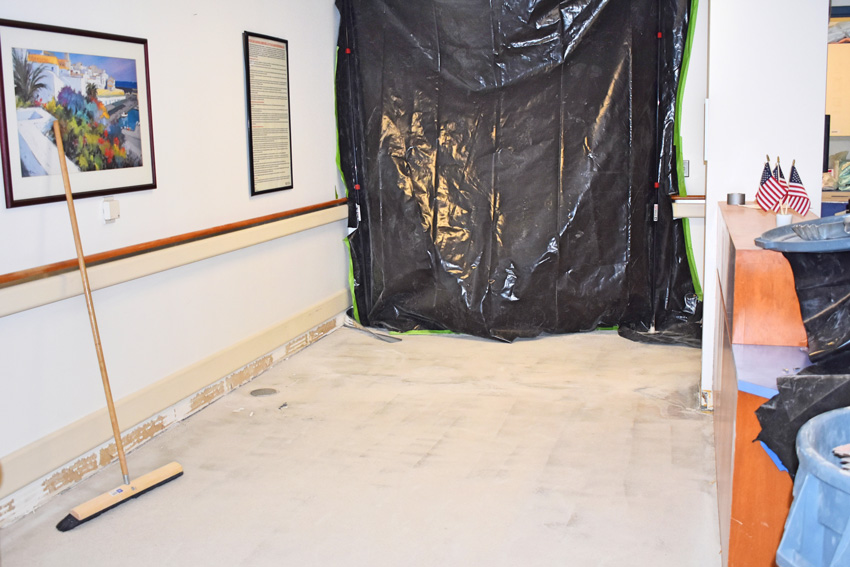
Containment barriers are used to prevent dust from entering patient-care areas.
The ICRA training program offers construction professionals the hands-on experience necessary to select, build, and maintain the containment walls for every level of the work-area classification on the ICRA Matrix.
Controlling Airflow
Another way that airborne contaminants can be contained within the construction area and removed altogether is by controlling the contaminated air with negative air pressure. A negative air machine with high-efficiency particulate air (HEPA) filtration removes contaminated air from a sealed containment area and captures the contaminants. The filtered air is then exhausted outside of the containment area to create a negative air environment. This negative air pressure or vacuum effect helps to ensure that airborne pathogens do not escape the containment area and infiltrate the health-care facility through the HVAC system or other conduits.
During ICRA training, construction professionals will learn how to use HEPA units to scrub the air in a construction area and create a negative air environment to control the movement of airborne pathogens. They will also learn how to appropriately maintain the prefilters and filters on the negative air machine and monitor the negative air pressure to ensure the system is working correctly.
Walk-Off Mats, PPE, Anterooms
There are several other pieces of equipment and even another area, the anteroom, that help to prevent contaminants from leaving the construction area on construction workers or other people and objects that may visit the project site. Sticky mats or walk-off mats are commercial floor mats designed to remove dust and debris from the bottom of shoes or cart wheels. They are often placed at the entrance and exit of the work area. These mats will need to be appropriately secured and regularly maintained for optimum performance.
Personal protective equipment (PPE) and patient protective apparel (PPA) are clothing that is worn on the outside of a person’s personal clothing to prevent transmitting dust and dirt from workers to patients or hospital staff. These full-body suits can include gloves, shoe covers, and hoods. Part of the ICRA training addresses how to properly don and doff the PPE and PPA.
The anteroom is designed to separate the work area from the patient-occupied area of the hospital. It provides an additional level of protection with its own negative air machine to help contain the potential airborne contaminants from leaving the containment area. It can also be used to put on and remove PPE and PPA.
Work Without Disrupting Adjacent Operations
Another objective of an ICRA program is ensuring that the construction work occurs without disrupting adjacent operations. Sometimes the construction area is next to a patient room or surgical suite. Whatever the schedules of the surrounding areas, ICRA-trained professionals understand the importance of flexibility and will figure out how to plan the completion of the construction job so that it doesn’t interfere with patient comfort or other hospital operations. Contractors can be scheduled in second or third shifts to accommodate the needs of the health-care space.
The Available ICRA Training Programs
In recognition of the truly collaborative nature of infection control, two ICRA training programs were developed to address the needs of all construction-related professionals and health-care professionals that could benefit from the knowledge of ICRA protocols and procedures. Architects, engineers, hospital staff, interoffice contractor personnel, project managers, contractors, and subcontractors’ owners could all help to participate more fully in containing contaminants and infectious agents during construction in occupied health-care facilities by attaining the proper ICRA training certification or awareness.
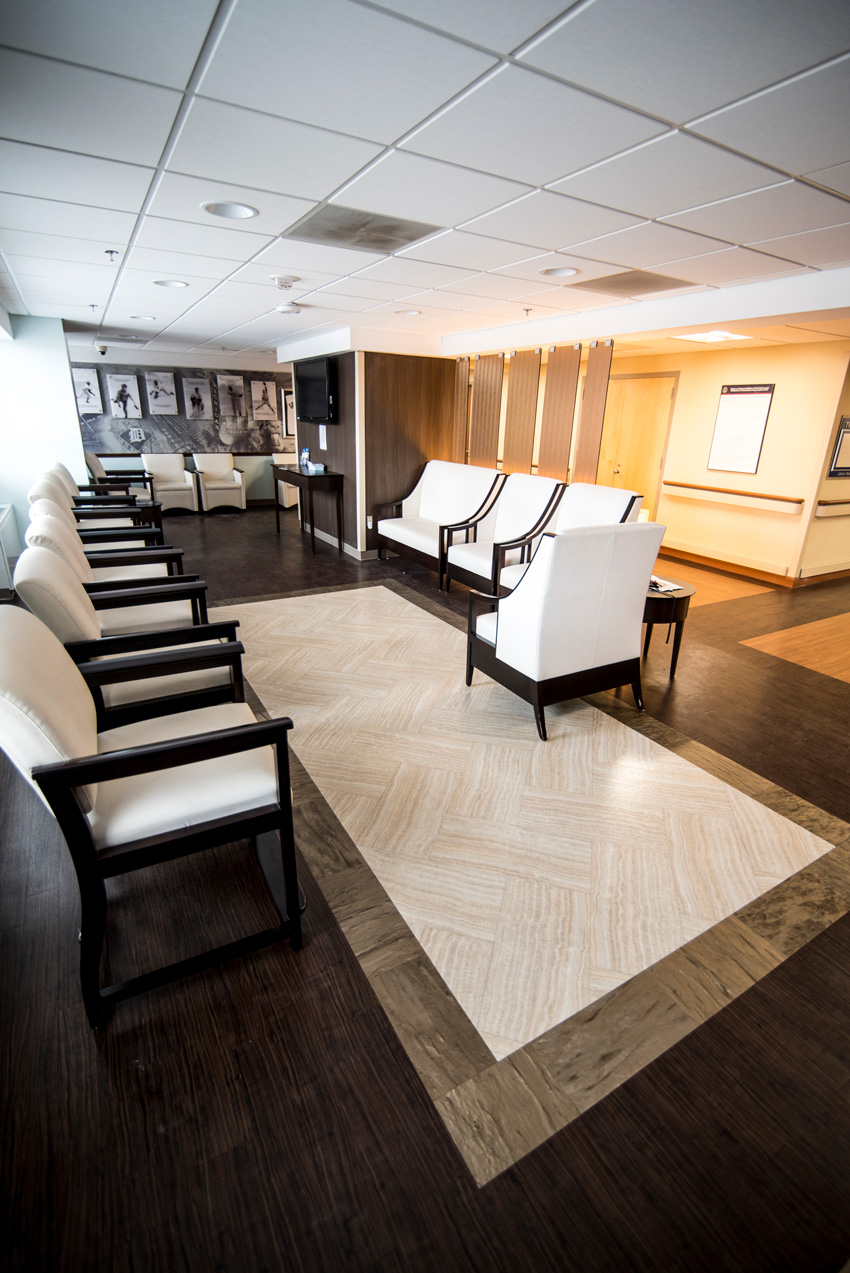
The ICRA training program helps all construction-related professionals understand and execute the proper protocols and procedures that keep patients safe during construction in occupied health-care facilities.
Upon the completion of either course, each professional receives three credentials: a certification of completion, a photo ID badge, and a hard hat sticker. This enables attendees to prove and employers to verify that members of their team achieved the proper ICRA training certification or awareness.
The 8-Hour ICRA Training Program
The 8-Hour Awareness ICRA training program is tailored for all building trades professionals and health-care professionals. These professionals will benefit from a high-level awareness of the ICRA protocols and procedures that will prevent the spread of infection during construction projects in the occupied health-care space. This one-day class explains the potential issues that can occur during occupied construction jobs and the fundamental rules of infection control. After attending this course, participants will be able to engage in conversations with a facility’s ICRA team in a more meaningful and informed way and help the construction team achieve compliance with ICRA protocols through improved planning in the design and construction phases of the project.
Designers taking the ICRA training will be able to incorporate ICRA awareness in the preplanning stages of the project, allowing them to include the temporary containment walls on the drawings and create more visibility for ICRA protocol support throughout the design process.
The 24-Hour ICRA Training Program
The 24-Hour ICRA training program is tailored for all carpentry professionals that will be responsible for building and maintaining the construction-containment walls. The 24-Hour ICRA training consists of 16 hours of in-class instruction and 8 hours of hands-on learning in the shop. Participants will learn how to select and construct effective containment barriers, create and maintain negative airflow environments, and practice using several other pieces of infection-containment equipment before it is necessary on the project site. It should be noted that there are also efficiency and productivity gains that are realized by having teams that are able to construct the necessary areas and systems correctly the first time.
Benefit of Utilizing the 24-Hour and 8-Hour Awareness ICRA Training Programs
These ICRA training programs ensure that all professionals are familiar with the proper ICRA protocols/procedures and why they have to be followed. Working with a greater awareness and compliance of health-care facilities’ infection-control and infection-prevention protocols is a proactive approach that will directly affect patient safety and job-site safety in a positive way. By utilizing both the 24-Hour and 8-Hour ICRA training programs, everyone becomes involved in the common goal of raising the bar on patient safety during construction.
Specifying ICRA On A Project
Specifying that ICRA-trained professionals be selected for occupied health-care projects offers many benefits to the patients, facility, and construction team. It should be noted that in order for the ICRA training to occur before the project commences, designers will want to make that requirement known as early as possible in the planning and specification process. For more information on participating in ICRA training or specifying ICRA training for the construction-related professionals on a health-care project, visit icraforbuilders.com.
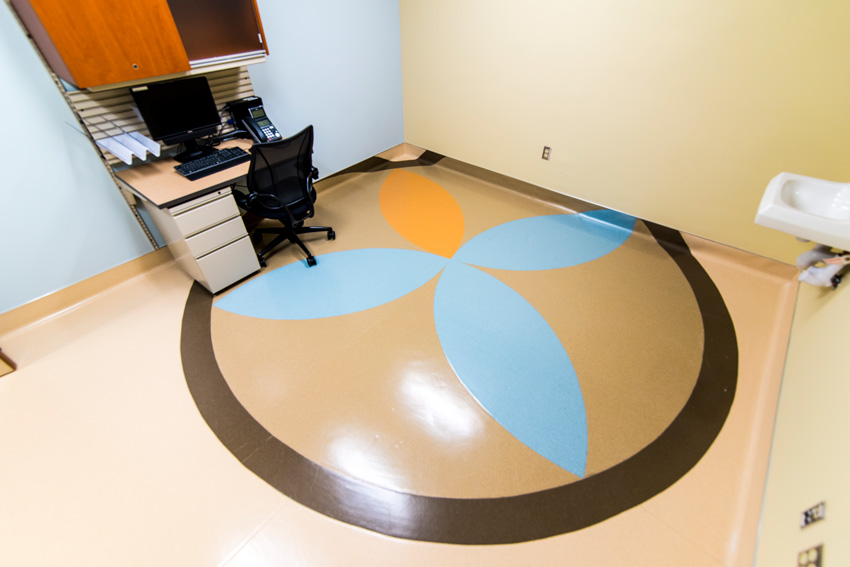
These new training programs enable teams to provide safe and sterile health-care environments during and after construction projects in new and occupied facilities.
Construction projects in occupied health-care facilities have been creating dust and dirt and releasing potentially harmful pathogens into the healing environment for centuries. Thankfully, now there are proven procedures that are designed to keep these construction-related by-products away from patients. Containment walls, negative airflow, walk-off mats, and more are now available to protect patients from being exposed to any of the contaminants that could cause another disease or infection. Now that the technology exists, it is time to make sure that the construction professionals working in health care are trained in the proper techniques. Designers can attain ICRA training to be able to participate more fully in these important discussions whenever working on a project in an occupied health-care facility and specifying that all construction-related personnel achieve ICRA training will only help them to build out a brilliant design, without causing harm to one body.
In the end, whether the training helps floorcovering installers provide floors that are safer and more sterile or enables a larger construction team to protect a facility full of immune-compromised patients, the INSTALL and ICRA training programs now available help designers deliver health-care spaces in a more health-conscious way.
Jeanette Fitzgerald Pitts has written dozens of continuing education articles for Architectural Record covering a wide range of building products and practices.

|
As the industry’s most endorsed/specified training program, INSTALL leverages partnerships to bring together field know-how and in-depth product expertise. The INSTALL Promise is to deliver top-quality flooring installations in which we all can all take pride. When you specify a flooring system, you want to make sure it performs to your customer’s expectations. INSTALL is there to make sure it does.
|




















